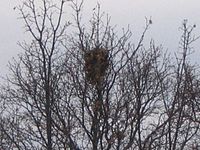
Eastern gray squirrel
Background to the schools Wikipedia
SOS Children, an education charity, organised this selection. SOS mothers each look after a a family of sponsored children.
| Eastern Gray Squirrel | |
|---|---|
 |
|
| Conservation status | |
|
Least Concern
|
|
| Scientific classification | |
| Domain: | Eukarya |
| Kingdom: | Animalia |
| Phylum: | Chordata |
| Class: | Mammalia |
| Order: | Rodentia |
| Family: | Sciuridae |
| Genus: | Sciurus |
| Subgenus: | Sciurus |
| Species: | S. carolinensis |
| Binomial name | |
| Sciurus carolinensis Gmelin, 1788 |
|
The eastern gray squirrel (Sciurus carolinensis) is a tree squirrel native to the eastern and midwestern United States and to the southerly portions of the eastern provinces of Canada. The specific epithet, carolinensis, refers to the Carolinas, where the species was first recorded and where the animal is still extremely common. The native range of the eastern gray squirrel overlaps with that of the fox squirrel (Sciurus niger), with which it is sometimes confused, although the core of the fox squirrel's range is slightly more to the west.
A prolific and adaptable species, the gray squirrel has been introduced to, and thrives, in several regions of the western United States. It has also been introduced to Britain, where it has spread across the country and has displaced the native red squirrel, Sciurus vulgaris. In Ireland, the red squirrel has been almost entirely displaced and there are concerns that the same might happen in Italy.
Description
As the name suggests, the eastern gray squirrel's fur is predominantly gray but it can have a reddish tinge. Its belly is white and it has a large bushy tail. Particularly in urban situations where the risk of predation is reduced, both white- and black-colored squirrels are quite often found. The melanistic form, which is almost entirely black, is predominant in certain populations and in certain geographic areas, such as in large parts of southeastern Canada. There are also genetic variations within these, including gray squirrels with black tails and black colored gray squirrels with white tails.
Behaviour
Like many members of the family Sciuridae, the eastern gray squirrel is a scatter-hoarder; it hoards food in numerous small caches for later recovery. Some caches are quite temporary, especially those made near the site of a sudden abundance of food which can be retrieved within hours or days for re-burial in a more secure site. Others are more permanent and are not retrieved until months later. It has been estimated that each squirrel makes several thousand caches each season. The squirrels have very accurate spatial memory for the locations of these caches, and use distant and nearby landmarks to retrieve them. Olfaction is used once the squirrel is within a few centimeters of the cache.

Gray squirrels build a type of nest, known as a drey, in the forks of trees. The drey consists mainly of dry leaves and twigs. They may also build a nest in the attic or in the exterior walls of a house, often to the consternation of the homeowner. They will raid bird feeders for millet and sunflower seeds but they are reported to dislike the slight capsaicin content of safflower seeds. So-called anti-squirrel birdseed preparations are available; the seeds are coated with chili pepper. The birds are unaffected because they cannot taste the capsaicin. Mixing hot pepper flakes into regular birdseed works well as a squirrel deterrent. Gray squirrels are notorious for digging bulbs from gardens. Their reputation for these habits has led some to call them "tree rats" or "fuzzy-tailed rats". Eastern gray squirrels have a high tolerance for humans and inhabit residential neighborhoods and urban parks. Wild squirrels may even be enticed to accept food from people.
Predators include humans, hawks, mustelids, skunks, raccoons, domestic and feral cats, snakes and owls. On occasion, a squirrel may lose part of its tail while escaping a predator.
Communication
As in most other mammals, communication among gray squirrels involves both vocalizations and posturing. The eastern gray squirrel has a quite varied repertoire of vocalizations, including a squeak similar to that of a mouse, but more low pitched, a chatter, and a raspy "mehr mehr mehr". Other methods of communication include tail-flicking.
Diet
The eastern gray squirrel consumes a variety of foods, including insects, nestling birds, various seeds and acorns, walnuts, and other nuts.
Distribution
The eastern gray squirrel is common throughout most of its natural range and wherever it has been introduced. It readily becomes tolerant of humans and learns to take food left or offered by picnickers.
Introductions
The eastern gray has been introduced to a variety of locations on the west coast of North America, including the states of Washington and Oregon and, in California, to the city of San Francisco and the Peninsula area of San Mateo and Santa Clara counties, south of the city. It has become the most common squirrel in many urban and suburban habitats in the western United States north of central California. At the turn of the 20th century the eastern gray squirrel was introduced into South Africa and England. It spread rapidly across England and then became established in both Wales and parts of southern Scotland. There it has almost entirely displaced the populations of native red squirrels. Eastern grays have also been introduced to Italy, and the European Union has expressed concern that it will similarly displace the red squirrel from parts of the European continent.
Displacement of red squirrels
In the United Kingdom, the animal is known simply as the grey squirrel and it has few natural predators. This has aided their rapid population growth and has led to the species being classed as a pest. Measures are being devised to reduce their numbers, including one plan for famous television chefs to promote the idea of eating gray squirrels. In areas where relict populations of red squirrels survive, such as the island of Anglesey, programmes seeking to eradicate gray squirrels are in progress in an effort to allow red squirrel populations to recover.
Although complex and controversial, the main factor in the displacement of red squirrels by grays is thought to be the grays' greater fitness and, hence, a competitive advantage over red squirrels on all measures. Gray squirrels tend to be larger and stronger than reds and have been shown to have a greater ability to store fat for winter. These factors are thought to result in gray squirrels competing effectively for a larger share of the available food, resulting in relatively lower survival and breeding rates among red squirrels. Parapoxvirus may also be a strongly contributing factor; red squirrels are fatally affected by the disease, while gray squirrels are unaffected but thought to be carriers. Red squirrels are also less tolerant of habitat destruction and fragmentation than are the more adaptable gray squirrels, resulting in a decrease in the population of reds and a resultant expansion in the number of gray squirrels.
Similar factors appear to have been at play in the Pacific region of North America, where the native American red squirrels have been largely displaced by grays in parks and forests throughout much of the region.
-
GrayDSC01824.JPG
A gray squirrel on a tree branch.
-
2007 10210194.JPG
-
2007 10210180.JPG











